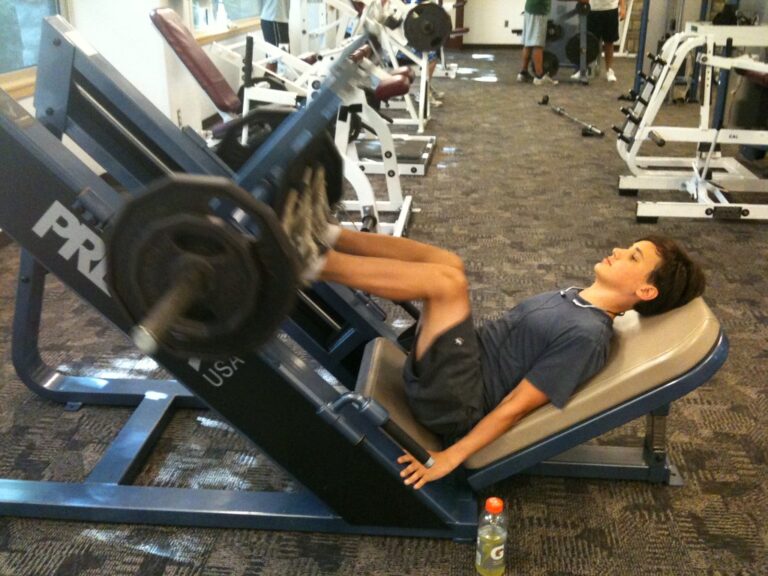leg press to squat calculator: Conversion Guide
Estimated Squat Weight: 0 lbs
Estimated Squat Weight: 0 lbs
Are you someone who loves leg press but struggles with squats? Or are you a squat enthusiast looking to switch up your workout routine? Either way, a leg press to squat calculator, also known as a squat conversion guide, could be just what you need to determine how much weight you can safely use when transitioning between the two exercises.
This tool allows you to calculate the leg press squat equivalent and understand the leg press to squat ratio. In this blog post, we will guide you on how to use this squat-to-leg press conversion calculator step-by-step.
We’ll also talk about the benefits and drawbacks of using a leg press to squat calculator, also known as a lifter, to compare your weight to others of a similar weight.
With this tool, you can easily convert your leg press weight into an equivalent squat weight, giving you a better understanding of your strength and progress in both exercises.
The calculator takes into account factors like body geometry and weight distribution to provide an accurate leg press equivalent to squat. So why wait? Let’s dive in and get started on this exciting journey towards achieving your fitness goals!
What is a leg press to squat calculator and how does it work?

A leg press to squat calculator is a tool that helps you determine the equivalent squat weight based on the weight you can leg press. It takes into account factors such as leverage, muscle activation, and biomechanics to provide an estimate of your squat strength relative to your leg press weight
The calculator uses a conversion formula that considers the angle of the leg press machine (usually 45°) and your body weight to determine the leg press actual weight and then converts it to the equivalent barbell back squat weight.
Step-by-step guide on how to use leg press to squat calculator
Step 1: Enter Your Leg Press Weight
Locate the “Leg Press Weight” input field.
- Enter the weight you can leg press into this field. Ensure that you specify the appropriate unit (either pounds or kilograms) based on your preference. This is the Wpress value used in the conversion formula.
- Example 1: Suppose you can leg press 200 pounds on a 45° leg press machine, and you want to use pounds as the unit of measurement. You would enter “200” into the “Leg Press Weight” input field.
Step 2: Select Your Preferred Unit
The next step is to choose your preferred unit for the results. You can select either “lbs” (pounds) or “kg” (kilograms) from the “Select Unit” dropdown.
- Example 2: If you prefer to work with kilograms, select “kg” from the dropdown.
Step 3: Choose Your Gender
The calculator provides an option to select your gender to refine the estimate and provide a male comparison or female comparison. Please select either “Male” or “Female” from the dropdown menu labeled “Select Gender”.
- Example 3: If you are a male, select “Male” from the dropdown. If you are a female, choose “Female.”
Step 4: Calculate Your Estimated Squat Weight
Click the “Calculate” button.
- The calculator will perform the squat to leg press conversion based on your leg press weight (Wpress), unit, gender, and body weight (Wbody) using the formula: Wsquat = (Wpress * sin45°) – Wbody.
- The estimated squat weight (Wsquat), along with the chosen unit, will be displayed in a separate box. This represents the leg press squat equivalent weight.
- Example 4: After clicking “Calculate,” the calculator might display “Estimated Squat Weight: 330.00 lbs” if you are male, or “Estimated Squat Weight: 110.00 kg” if you are female. These values are based on the squat to leg press ratio and conversion factor used by the calculator.
Step 5: Reset the Calculator
If you want to start over or perform another calculation, click the “Restart” button.
- This will clear the input fields and hide the result box, resetting the total lifts entered count.
- Example 5: Clicking “Restart” will clear the leg press weight, selected unit, and gender, allowing you to input new values.
Benefits of using a leg press to squat calculator

Using a
calculator offers several benefits in your strength training routine. Firstly, it helps you accurately calculate the weight you should be squatting based on your leg press strength and trigonometry calculations.
This ensures that you are challenging yourself enough without risking injury, whether you are aiming for an average lift or an elite lift. Additionally, the calculator allows you to track your progress and strength gains over time by providing a daily count of your lifts.
By consistently monitoring your performance, you can set and achieve realistic goals based on strength standards.
Another benefit is that it saves time and effort in manually calculating the conversion, as the calculator uses the formula Lf x Sin(A) = Sf, taking into account the weight of the person, to determine the appropriate force of the leg press for your squat.
Furthermore, the leg press to squat calculator enables you to easily adjust the weight of the leg press to target specific muscle groups in the squat, such as the quadriceps, hamstrings, and glutes. This allows for more effective and targeted strength training.
Moreover, by using the calculator, you can ensure proper form and starting position, making it an easier exercise and reducing the risk of injury during your compound movement squatting exercises.
This ensures that your leg muscles are the primary focus of the workout while also engaging your core strength and lower back for stabilization. Finally, incorporating a leg press to squat calculator into your workouts can greatly improve your lower body strength, hypertrophy, and overall physical fitness.
It provides you with a precise conversion guide, helping you maximize your results and optimize your training.
Drawbacks of using a leg press to squat conversion calculator

While a leg press to squat calculator can be a helpful tool for estimating your squat weight, it’s important to be aware of its limitations and potential for bad form.
The calculator provides an estimate and may not be 100% accurate for everyone due to variations in individual body mechanics and strength levels.
It’s essential to remember that squatting involves more than just the lower body, as it also utilizes upper body strength for stability and balance. Additionally, relying solely on the calculator for training may limit the variety of exercises you can incorporate into your lower body strength routine.
To build proper squatting form and maximize strength gains, it’s recommended to also perform squats regularly and focus on developing good form and technique, especially for a tall person.
The leg press machine provides mechanical assistance, which can lead to an overestimation of your actual squat strength. Emphasizing a well-rounded approach to strength training will ensure optimal results and minimize the drawbacks of relying solely on a leg press to squat calculator.
Conclusion
Using a leg press to squat calculator can be a helpful tool in your workout routine. It allows you to determine the weight you should be lifting on the leg press machine based on your squat strength, taking into account the leg press vs squat weight difference.
This can be beneficial for those who may have limitations or injuries that prevent them from safely performing squats with a barbell. However, it’s important to keep in mind that a leg press weight calculator is just a guide and should not be the sole determinant of your workout.
Referring to a leg press weight chart or leg press machine weight chart can provide additional insights, but it’s always best to consult with a fitness professional or trainer who can assess your individual needs and provide personalized recommendations.
In conclusion, while a leg press to squat calculator can offer convenience and assistance, it should be used as a supplementary tool in your fitness journey.
Remember to listen to your body, prioritize proper form, and seek guidance from professionals for optimal results. By understanding how leg press translates to squat and using the calculator judiciously, you can effectively incorporate both exercises into your strength training program and achieve your fitness goals.
